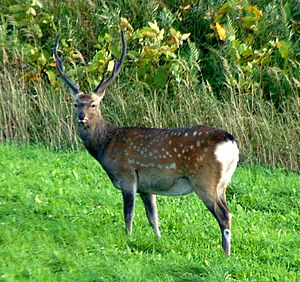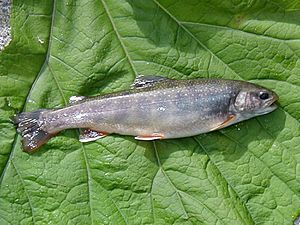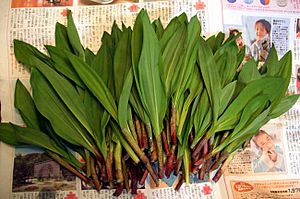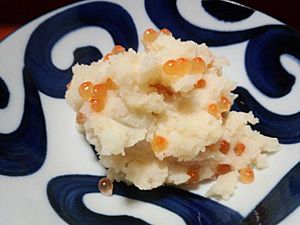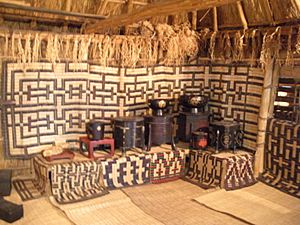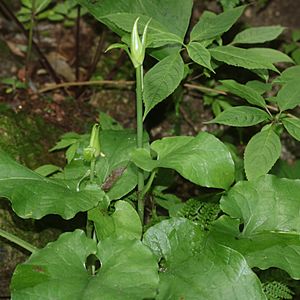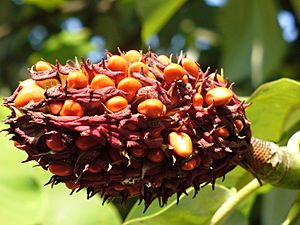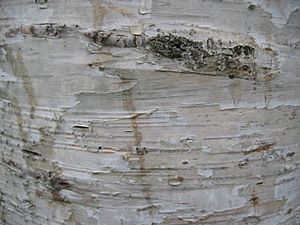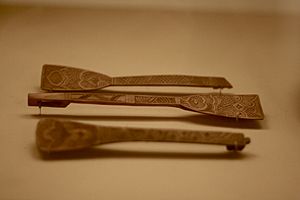Ainu cuisine facts for kids
Ainu cuisine is the special way of cooking food for the Ainu people, who live in parts of Japan and Russia. Their food is quite different from the food of most Japanese people. For example, Ainu cooking rarely uses raw meat like sashimi. Instead, they often boil, roast, or cure their meat. Also, traditional Ainu food didn't use miso, soy sauce, or sugar. However, you might find these in modern Ainu dishes today. Most Ainu people now live on Hokkaidō island in northern Japan. Long ago, they also lived on the Kuril Islands, the southern part of Sakhalin, and some areas of northern Honshū.
You won't find many Ainu restaurants around the world, but a few do exist. For example, there's Haru Koro in Tokyo, Ashiri Kotan Nakanoshima in Sapporo, and Poron'no and Marukibune in Akan, Hokkaidō.
Contents
What Ainu Food Is Like
Traditional Ainu cooking uses meats from fishing and hunting, like salmon and deer. They also gather wild plants from the mountains, such as Cardiocrinum cordatum bulbs (called turep) and acorns. They also grow different grains and potatoes. A special part of Ainu cooking is using a lot of oils for flavor. Because the Ainu relied on local animals and plants, different areas used different ingredients, depending on what was easiest to find.
Besides salt, they use fats (sum) from cod, sardines, herring, sharks, seals, whales (humpesum), sika deer (yuksum), and bears (pasum) to make dishes taste good. Nowadays, miso and soy sauce are also used. Soups can be made with kelp, animal bones, and dried fish. For seasoning, they use pukusa (which is like a Siberian onion), berries from the Amur corktree, and wavy bittercress.
Main Ingredients
Animals from Hunting
The most important animal for hunting was the sika deer. Ainu hunters used poisoned arrows or herded deer off cliffs to catch them. In the past, deer were so common in Hokkaidō that people said you could "put the pot on the fire, then go hunting" because it was so easy to find deer.
- Brown bear (kimun kamuy)
- Chipmunk (ruop)
- Eurasian jay (parkew)
- Eurasian tree sparrow (amameciri)
- Ezo red fox (cironnup)
- Hazel grouse (humiruy)
- Japanese marten (hoinu)
- Mallard (kopeca)
- Oriental turtle dove (kusuyep)
- Rabbit (isopo kamuy)
- Raccoon dog (moyuk)
- Sika deer (yuk)
Fish and Sea Animals
The Ainu fished in the sea using dugout canoes and harpoons for large sea animals. They used nets and fishing rods for smaller creatures. Whales that washed ashore were very valuable because it was usually impossible to catch them with canoes and harpoons. However, some Ainu did hunt whales in Funka Bay using poisoned harpoons. The Ainu also used fishing rods, nets, traps (uray), and fishing baskets (raomap) to catch freshwater fish.
- Bathyraja lindbergi (uttap)
- Capelin (susam)
- Cod (erekus)
- Crucian carp (rampara)
- Dolphin (tannup)
- Flounder (samampe)
- Fur seal (unew)
- Japanese dace (supun)
- Japanese fluvial sculpin (cimikani)
- Japanese huchen (ciray)
- Japanese smelt (tokikar)
- Masu salmon (icankot)
- Ocean sunfish (kinapo)
- Pacific herring (heroki)
- Pond loach (cicira)
- Salmon (kamuycep)
- Saffron cod (komay)
- Sardine (iwashi)
- Sea lion (etaspe)
- Seal (tukar)
- Shark (same)
- Sturgeon (yupe)
- Swordfish (sirkap)
- Trout (icaniw)
- Whitespotted char (tuksis)
Gathered Plants
While men hunted and fished, women gathered edible plants, starting in early spring. They used tools like the saranip (a bag made from Japanese lime tree fibers), the menoko makiri (a small women's knife), itani (a digging stick), and the shitap (a small pick made from deer horn). One very important plant gathered in spring was the Siberian onion (pukusa). In summer, large amounts of Cardiocrinum cordatum bulbs (turep) were gathered because they were important for storing food.
Spring
- Anemone flaccida (ohaw kina or pukusakina)
- Angelica (cihue)
- Butterbur (makayo)
- Bracken (warumbi)
- Cow parsnip (pittok)
- Hog peanut (eha)
- Japanese butterbur (korkoni)
- Japanese mugwort (noya)
- Japanese spikenard (cimakina)
- Lance asiabell roots (topmuk)
- Long-stamen chive bulbs (mempiro)
- Maianthemum japonicum (pepero)
- Marsh-marigold roots (pui)
- Ostrich fern (sorma)
- Siberian onion (pukusa)
- Symplocarpus renifolius (sikerpe kina)
- Thistle (ancami)
Summer
- Cardiocrinum cordatum bulbs (turep)
Fall
- Amur cork tree berries (sikerpe)
- Crimson glory vine fruit (hat)
- Hardy kiwi fruit (kutci)
- Hen-of-the-woods mushroom (yuk karus)
- Japanese chestnuts (yam)
- Japanese emperor oak acorns (nisew)
- Japanese rose fruit (maw)
- Mushroom (karus)
- Oak acorns (pero)
- Walnuts (neshiko)
- Water caltrop fruit (pekampe)
Farmed Crops
Farming was done in Hokkaidō even before the Ainu culture fully developed. However, farming became less common in the 12th century. This might be because people focused more on hunting and fishing to trade dried fish and furs with Honshū. Over time, new crops like potatoes, pumpkins, and beans were introduced.
- Bean varieties (mame)
- Buckwheat (soba)
- Foxtail millet (munchiro)
- Japanese millet (piyap)
- Potato (imo)
- Proso millet (menkul)
- Pumpkin (kabocha)
- Turnip (atane)
Main Ainu Dishes
Citatap
Citatap means "that which has been pounded" in Ainu. It's a dish of meat or fish that has been pounded, similar to the Japanese method called tataki.
How to Make Citatap
- Salmon heads, milt, and leftover pieces from filleting are placed on a round wooden cutting board (itatani). The meat is then chopped and pounded with a heavy, sharp tool like a hatchet.
- The pounded mixture is flavored with chopped spring onion, pukusa, or long-stamen chive.
- Finally, citatap is seasoned with dried kelp and salt.
Besides salmon, many other meats and fish can be used for citatap, such as Japanese dace, bathyraja lindbergi, masu salmon, Japanese fluvial sculpin, deer, bear, raccoon dog, rabbit, and chipmunk. Citatap was especially good for older animals, as it made tough meat easier to eat.
Citatap was mostly made in winter when food spoiled more slowly, and it could be eaten for several days. If it wasn't very fresh, it was rolled into balls and added to soup.
Ohaw
Ohaw is a soup made by boiling fish or meats with various vegetables. It can be thin like soup or thicker, like a Japanese nabemono (hot pot), with lots of ingredients. The Ainu were hunter-gatherers, so they didn't have one main food, but ohaw was a very important dish in their food culture. It's thought to be the origin of Hokkaidō dishes like Ishikari nabe. There are no strict rules for ohaw ingredients, but it was generally made like this:
- A broth is made by heating animal bones or small dried fish in water.
- Roughly chopped meat or fish is added and cooked. Dried meats and fish need longer cooking times. The foam that forms on top is not removed, as people believed it had healing properties.
- Root vegetables or those that take longer to cook are added first, then fibrous mountain vegetables, and finally leafy vegetables. The soup cooks until everything is soft.
- The soup is flavored with animal or fish fats, a little salt, and topped with ground dried kelp or dried pukusa.
Different kinds of ohaw are named after their main ingredient, such as cep ohaw (fish soup), kamuy ohaw (bear soup), kam ohaw (meat soup), and kina ohaw (vegetable soup). Anemone flaccida was so good for soups that it was called ohaw kina, meaning "soup grass."
Rataskep
Rataskep literally means "mixed food." Wild vegetables and beans are stewed until they are soft and the water has evaporated. Then, the mixture is mashed and seasoned with bear or fish oils and a little salt. Rataskep was eaten every day and also used as offerings in ceremonies because it was considered a sacred food. There are endless varieties using different ingredients. Here are a few examples:
Sikerpe kina rataskep
- Dried symplocarpus renifolius (sikerpe kina) is soaked in hot water, then boiled slowly for hours until the water is gone. It's cut into small pieces and seasoned with animal fat and salt.
Pukusa rataskep
- Beans are boiled until soft. Then, Siberian onion (pukusa) stalks are added and cooked more. Finally, it's seasoned with animal fat and salt.
Cihue rataskep
- Made from angelica (cihue) gathered in early summer. Beans are boiled until soft, then angelica is added and boiled further. It's seasoned with animal and fish fats.
Kabocha rataskep
- Beans are boiled until soft. Dried strips of pumpkin (kabocha) are soaked in water, then boiled with the beans. When the pumpkin starts to break apart, the rataskep is seasoned with fish fats and salt and topped with berries from the Amur corktree (sikerpe).
Cipor rataskep
- Also called cipor imo. Potatoes (imo) are boiled with their skins on. Salmon roe (cipor) is cooked in a separate pot over low heat until it breaks down. The skins are removed from the potatoes, which are then sliced thickly and added to the pot with the salmon roe. Salt is added, and everything is mixed well.
Nisew rataskep
- The outer shell is removed from acorns (nisew). They are then boiled and drained many times with the seed coat on to remove their bitter taste. They are then placed in water with beans and boiled together. This water is thrown away. Fresh water is added, and the mixture is boiled until soft. Then, corn flour is added and cooked until it's the right thickness. Rice flour is added, the mixture is kneaded, and salt and animal fats are added for seasoning.
Sayo
Sayo is a thin porridge made by boiling Japanese millet or rice. Usually, only the grains are boiled, but sometimes gathered vegetables are added. Unlike porridges in farming societies, sayo was not a main meal. Instead, Ainu people would fill up on fatty soups and grilled meats, then drink sayo like tea to cleanse their palate. Because of this, sayo was made in a special small pot to avoid mixing it with oils from other dishes. They also used a separate ladle just for sayo (sayo kasup), not the usual soup ladle (kasup). Since the porridge used very few grains, about 1.8 liters was enough for one person for a month.
Here are some examples of sayo varieties:
Turep sayo
- Sayo that contains on turep, which are the fermented leftovers from making Cardiocrinum cordatum (turep) starch. The hard, dried on turep is first ground with a mortar and pestle, then soaked in water. The sediment is removed, formed into small dumplings about three centimeters wide, and cooked in the sayo. Sayo that contains the Cardiocrinum cordatum bulbs themselves is also called turep sayo.
Irup sayo
- The starch from Cardiocrinum cordatum bulbs is made into dumplings (sito) and placed in the sayo.
Ento sayo
- Sayo that contains Elsholtzia ciliata (ento), a mountain plant. This type of sayo was liked for its special smell.
Satsirari sayo
- The lees (satsirari), which are the leftovers from making rice wine (tonoto), are placed in sayo.
Kikinni sayo
- Sayo that contains bark from the bird cherry tree (kikinni).
Cipor sayo
- Salmon roe (cipor) is boiled with the grain porridge. Fresh salmon roe was only eaten in the fall as a special treat. During other seasons, salted and dried roe (sat cipor) was used.
Sito
Sito are a type of dumpling. The name sito comes from the Japanese word shitogi, which means dumplings or a paste made from grinding raw grains. Traditionally, sito were considered a special treat because it took a lot of time and effort to make the flour by grinding grains with a mortar and pestle. So, it wasn't an everyday food. Instead, it was made as offerings for important days like the Bear Festival (iomante) and Ancestors’ Festival (icarup).
Common ingredients were proso millet (mankul), foxtail millet (munchiro), and rice (siamam). However, sito made with proso millet were considered the most traditional. Over the years, other ingredients like pumpkin (kabocha) and potato (imo) were added. Similar to Japanese kusamochi, the Ainu also made sito mixed with Japanese mugwort (noya). People enjoyed their taste, which reminded them of spring.
How to Make Sito
- Polished grains are soaked overnight, then drained.
- The grains are placed in a large mortar, and several people sing while pounding the grain with large pestles (iutaupopo).
- The flour is mixed with hot water and shaped into round, flat dumplings about 7 or 8 centimeters wide and 1 centimeter thick.
- The dumplings are boiled in a large pot, making sure they don't stick to the bottom.
Sito meant for offerings were placed in special lacquerware boxes (sintoko), wooden bowls (patci), on small trays (otcike), or put on sticks made from cornus controversa and presented to the gods. When eaten by people, sito were served with partly crushed salmon roe or a sauce made by mixing oils with dried and crushed kelp.
Sito has a long history. Dumplings made from foxtail millet have been found in ancient Satsumon culture sites. Traditional Ainu cooking did not use steamed rice to make dumplings, unlike the Japanese who made mochi this way. The Ainu first learned about Japanese-style mochi after the Edo period, when more Japanese people moved to live in the same areas as the Ainu.
Preserved Foods
Dried Meat and Fish
The Ainu word for dried meat is satkam, while dried fish is called satcep, nikeruy, or atat.
Salmon was caught in large amounts, especially in the fall, more than could be eaten right away. So, it was made into preserved food that could last up to six months. First, the head and insides of the fish were removed. Then, it was dried on a rack outside before being brought inside and smoked over the hearth. Trout (icaniw) and Japanese char (tuksis) caught in summer were dried over a fire to keep flies away. These dried fish were eaten as they were, by pulling off the meat, or by soaking them in water and using them in soup or as a cooked dish. Salmon dried after laying eggs lost much of its flavor, so it was often stewed with added fish fats to make it taste better.
Milt (up) and salmon roe (cipor) from the fish were also dried and preserved. Later, they were used in sayo or to make broth for ohaw.
While it was common to eat all parts of a bear raw when it was fresh, including its meat and organs, the Ainu also preserved some meat for times when hunting was not possible. Meat from deer (yuk) and brown bears (kimun kamuy) was cut into thin strips and simmered in a large pot. Once the juices were removed, the meat was hung over the fire inside to dry and smoke. This satkam was eaten as is, or boiled again to make a soup.
Cardiocrinum cordatum Starch
The starch from Cardiocrinum cordatum bulbs (turep) was even more important in the Ainu diet than grains.
The Ainu word for the fourth month of the lunar calendar means "soon to be time to dig up turep month," and the fifth month means "digging up turep month." This was when Ainu women would take their sacks (saranip) and digging sticks (itani) and go into the mountains to gather the bulbs. The gathered bulbs were made into starch using this method:
- Remove leaves and roots from the bulb, peel the scales one by one, and rinse them in water.
- Place the scales in a large bucket. Grind them until a sticky paste forms, using the head of a hatchet as a pestle. Pour a lot of water into the bucket and let it sit for about two days.
- After a few days, fine fibers and skins will float to the surface, forming a foam, and the starch will settle to the bottom. The fibrous foam is removed and saved for making on turep. The starch collected at the bottom is separated into two types: a semi-liquid secondary starch and a powdered primary starch.
These two types of starch were dried and preserved. Before drying, they were also used to make fresh foods. The primary starch was mixed with water and poured into hollow plant stems from Japanese knotweed (kuttar) or Parasenecio hastatus (wakkakutu). These were then placed in fire ashes to cook into thin, noodle-like shapes. The secondary starch was formed into round dumplings, wrapped in leaves from Japanese butterbur (korkoni) or magnolia (pusni), then baked in fire ashes. They were then eaten with salmon roe or animal fats.
The secondary starch was used daily once it was dried for preservation. It was often made into dumplings and added to sayo. The primary starch was rarely eaten; instead, it was saved for gifts or used as medicine.
On turep
On turep means "fermented turep." It's a preserved food made by fermenting the fiber and skin left over from the turep starch-making process. It was made using this method:
- A sieve (icari) is used to collect the fiber and skins that float in the water after the turep bulbs have been crushed and soaked.
- The water is squeezed out of the fiber very well. Then, it's wrapped in leaves from Japanese butterbur (korkoni) or Parasenecio hastatus (wakkakutu) and left to ferment for three to ten days. This fermenting process is called "on."
- The fermented product is thoroughly ground with a mortar and pestle. Once pounded, it's kneaded, shaped into donut-like forms, and dried.
- A cord is passed through the center, and the on turep is stored by hanging it from a rack above the hearth.
On turep was eaten by smashing it, soaking it in water to form dumplings, and then placing them in sayo.
Pocche-imo
Pocche-imo is a preserved potato food also known as penekoshoi-imo or munini-imo. This process uses the very cold weather of Hokkaidō, similar to how chuño is made in South America.
After potatoes were harvested in the fall, the oddly shaped and small potatoes were left outside. The winter's cold would freeze the potatoes, and they would thaw again in spring. This freezing and thawing process would break down the potatoes, making them soft. Once soft, the potatoes were soaked in water and completely thawed. The starch that settled to the bottom of the water was collected, formed into balls, and placed in a warm spot to ferment. This created a fine potato flour. The flour was shaped into cakes and baked in the ashes of the fire. Then, bear fat or cipor (salmon roe) was added, and they were put into sayo to eat. In more recent times, with Japanese cultural influence, pocche-imo was often flavored with artificial sweeteners like saccharin and then deep-fried. The fried product was then eaten with nori or a mix of sugar and soy sauce.
Drinks
Traditional Drinks
Words for traditional drinks in the Ainu language include sake, tonoto, and askur. The word sake comes from Japanese, and tonoto also developed with Japanese influence, originally meaning food or drinks given by an important Japanese person. Ainu traditional drinks are not distilled; they are made from Japanese millet and look and taste similar to homemade sake.
All traditional drinks were made by women. Respected and virtuous women from nearby were considered suitable to lead this task.
The best ingredients for making these drinks were Japanese millet (piyapa) or proso millet (menkul). First, the grains were heated in a large pot with water until a porridge formed. Once cool, malt was mixed in. The Ainu either got malted grain from trading with the Japanese or made their own by boiling Japanese millet, acorns, and Cardiocrinum cordatum, then sprinkling powdered bark from the Cercidiphyllum tree on the finished product. The Ainu word for malt, kamtaci, is the same as the old Japanese word for malted rice, kamutachi.
The drink was stored in a special lacquered container (sintoko) and placed near hot embers to protect it from evil. Using a part of Apehuci-kamuy, the goddess of fire, in this way was believed to protect the drink from evil spirits and was a prayer for the success of the drink-making process. To further protect against evil spirits, a hatchet (tasiro) or an Ainu blade (emus) was placed on top of the sintoko. It was left to ferment for ten days near the kamuy puyar, the sacred window furthest inside the cise (Ainu home). Once the drink had fermented enough, the used coals were returned to the hearth, and the mash was strained through a sieve (icari) to remove the lees (sirari) and finish the drink. It was stirred using a special ladle (sake-pisakku), poured into a spouted bowl (etosup), then into serving bowls (itanki). When offering the drink to the spirits, an ikupasuy, a ceremonial stick, was dipped into a bowl of sake placed on a takaysara, a bowl stand. The drink on the ikupasuy was then spread onto the inau (sacred sticks). It was believed that one drop of drink in the human world would become an entire barrel in the spirit world when passed through the ikupasuy. The Ainu believed that everyone, including the spirits, enjoyed this drink.
The Ainu of the Hidaka region, like those near Shizunai, had a legend that tsunami spirits hated lees. So, they spread the lees around their homes to protect against tsunamis.
Tea
The teas drunk by Ainu were not made from the evergreen Camellia sinensis plant. Instead, they used seeds and bark from trees, or medicinal herbs that grew in the cool climate of Hokkaidō.
The Ainu would brew various plant materials to make tea, such as twigs and seeds from Japanese bigleaf magnolia (pusni) and kobushi magnolia (omawkusni). They also used twigs from Lindera umbellata (sumnuhas), bark from bird cherry (kikinni), leaves from Ledum palustre (haspo), stems and leaves from Vietnamese balm (ento), roots from Libanotis coreana (upew), roots from Heracleum lanatum (pittok), and roots from Angelica genuflexa (munusi). Cinnamomum camphora (ciprasu), which grows along the coast, was used in a similar way. In the Sakhalin region, drinks were made from boiled Ledum palustre (nuxca) stems and leaves, Rose rugosa (otaruxni), and Rubus matsumuranus (kinakaoxni) stems and leaves.
Today, Japanese tea imported from Honshu is very common.
Tree Sap
Some trees native to Hokkaidō contain sweet sap. The Ainu used the sap from these trees (niwakka, meaning "tree water") as a drink and to flavor foods.
Large amounts of sap flow from the trunk of the white birch (kapattatni) if it's damaged in the summer. This sap is called tatni wakka and was used as cooking water when no other water was available. A drink was also made by adding chopped Symplocarpus nipponicus to the sap along with flavoring. The Sakhalin Ainu would make a fermented drink by adding white birch sap to blackcurrant juice.
The painted maple (topeni, meaning "milk tree") is related to the sugar maple of North America. A sweet sap flows from its trunk if it's damaged. Trunks were scored in winter to make "sap icicles" that were eaten like popsicles. The sap was also boiled down to create a sweetener. This sweetener was then boiled with beans or water chestnuts to make a high-quality rataskep. Sap became less common when sugar became widely available during the Meiji era, but it became popular again for a short time during World War II when sugar was scarce.
Eating Habits and Tools
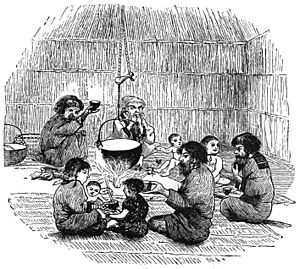
"Meal" in Ainu is "ipe." Traditionally, Ainu people ate two meals a day: breakfast (kunneywa ipe) and dinner (onuman ipe). A third meal, lunch (tokes ipe), was added later during the Taisho period. Sometimes, a night meal (kunne ipe) was eaten during night fishing or other late activities.
Food was moved from the cooking pot with a ladle (kasup) into a lacquerware bowl (itanki) for eating. These bowls were obtained through trade with the Japanese and were large enough to hold about 400 ml of food. Large pieces of meat or fish that didn't fit in the bowl were placed on mats woven from reeds. Foods like fish roasted on a spit or sito were eaten by hand. However, most other foods were eaten with chopsticks (pasuy) or spoons (parapasuy). Parapasuy literally means "wide chopstick." Both spoons and chopsticks were carved from wood.
When guests were present, the main woman of the house would offer food and say "ipeyan" (please eat). The guest would thank her, and if it was a valuable meal like bear meat, they would raise the food to their forehead in thanks before starting. However, the family would not say anything before eating if there were no guests. Once finished, it was customary to say "hunna" to show thanks for the food.
Similar to the Japanese, it was considered polite to eat all the food provided. Because of this, it was polite to use one's finger to wipe the remaining sauce from inside the bowl and lick it. This custom is why the Ainu name for the pointer finger is "itanki kem atsukep", which literally means "bowl-licking finger."



